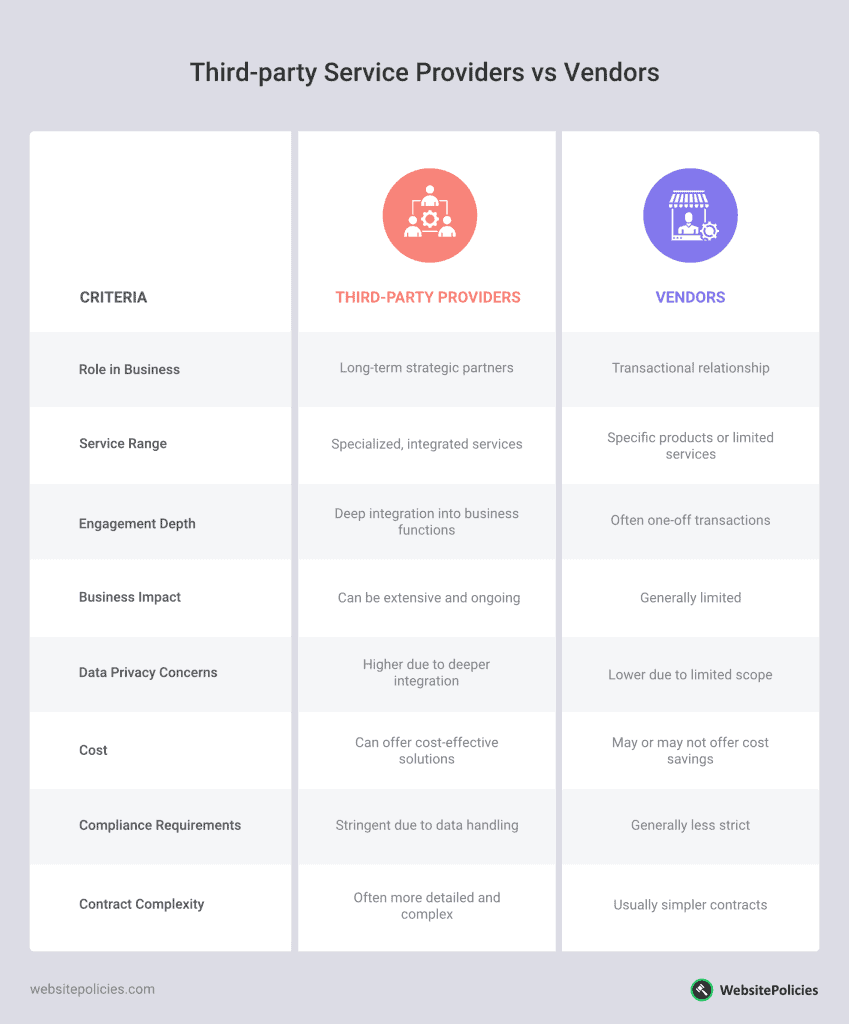These days, businesses and individuals alike often rely on external entities to fulfill specific needs, be it software, infrastructure, or specialized services. But what is a third-party service provider and how do they fit into the broader digital ecosystem?
This guide explains what third-party service providers do, their role, significance, and the myriad ways they influence and support modern operations.
Whether you’re a business owner looking to collaborate, an individual seeking clarity, or simply curious about it, this comprehensive guide has got you covered.
- Third-party service providers are essential for operational efficiency but come with data privacy risks. Your legal obligations for data protection remain intact even when outsourcing specialized tasks.
- Vendors and third-party providers are distinct. Vendors offer specific, transactional services, whereas third-party providers are more like strategic partners, deeply integrated into your operations.
- Data privacy is a shared duty. Employ best practices like comprehensive Data Processing Agreements, mandatory encryption, and regular audits to mitigate risks. Have an incident response plan in place.
Table of Contents
PRO TIP: Take the hassle of writing your own privacy policy away with our privacy policy generator trusted by over 200,000 businesses. It’ll save you hours of work and possible costly legal mistakes.
What is a Third-Party Service Provider?
A third-party service provider is an external organization or entity that performs specific functions or tasks on behalf of your company. Often, these providers offer services that are either not within your core competencies or are more economically feasible to outsource.
Let me drill down a bit for clarity. When you’re operating in an increasingly digitized and complex landscape, you often find that you can’t do it all. Specialized tasks like payment processing, data analytics, cloud storage, and digital marketing may fall outside your expertise.
Enter third-party service providers. They bring in their own capabilities, tools, and specializations to handle these elements, freeing you to focus on your core business operations.
However, in this delegation of duties, there is a very real and pressing concern: data privacy. You see, outsourcing doesn’t outsource your legal obligations. You remain responsible for the data you collect, even when it’s managed or processed by a third-party service provider.
The current legal landscape, shaped by regulations like GDPR in the EU, CCPA in California, and a host of other state, federal, and international laws, is quite stringent on data protection and privacy.
Therefore, due diligence is not just advisable; it’s imperative.
Vet your third-party providers with the same rigor you would use in hiring an in-house team. Examine their data privacy policies, security measures, and compliance records.
Because, in the eyes of the law, a weak link in their data protection protocols can directly implicate you.
PRO TIP: The responsibility to ensure compliance doesn’t merely rest with the service provider – it’s a shared responsibility.
Are Third-Party Providers Different From Vendors?
Yes, third-party service providers and vendors are different, though the terms are often used interchangeably. The distinction, subtle but significant, lies in the nature and scope of the services they provide for your operations.
Vendors typically offer a specific product or a more limited range of services, often on a transactional basis. You purchase goods or licenses, and the relationship may end there.
Think of a vendor as akin to a retailer; you walk in, buy what you need, and walk out. There’s usually not a lot of ongoing interaction or integration into your daily operations.
In contrast, third-party service providers are more akin to strategic partners. They offer specialized services that often integrate deeply into your business functions.
This could range from IT services to human resources to data management. The relationship is more dynamic and ongoing; these providers often become an extension of your team, to some extent.
Whether dealing with a vendor or a third-party service provider, your legal obligations, particularly concerning data protection, remain. However, the depth of those obligations can differ.
With a third-party service provider, given their more integral role in your operations, a lapse in their data governance can be more damaging and is likely to attract stricter regulatory scrutiny. It’s imperative to understand these nuances.
Here’s a comparison table highlighting key differences between third-party service providers and vendors:

Make sure to understand the difference between a vendor and a third-party provider as the level of due diligence required will differ.
Why Do You Need Third-Party Service Providers?
Third-party service providers aren’t just useful — they’re often essential for your online businesses and content platforms to operate efficiently and effectively.
When it comes to scaling your operations, honing your expertise, or simply managing the daily grind, these third parties offer resources and services that may be cumbersome, costly, or downright impossible for you to provide in-house.
Now let’s dig into it a bit. First off, specialization. These providers are experts in their fields, whether it’s cybersecurity, payment processing, or customer relationship management.
By outsourcing these specific tasks, you can focus on your core competencies, allowing you to do what you do best — whether that’s producing top-tier content or delivering unbeatable products.
Second, cost savings. Developing in-house capabilities for certain services can be a colossal investment, involving not only direct costs like salaries and equipment but also indirect costs like training and time to market.
Last but not least, there’s agility. The digital landscape changes at a breakneck speed. Third-party providers are designed to adapt to these changes, giving you the flexibility to scale your operations up or down, pivot your business model, or adopt new technologies as needed.
How Do Third-Party Providers Increase Data Privacy Risks?
When you engage with third-party service providers, it’s like adding more doors to a building; each new entrance can be a potential point of vulnerability.
One of the key challenges here is giving up some level of control over your data. You trust this external entity to maintain the same level of data privacy and security that you would, but there’s always the risk they won’t.
If they suffer a data breach or mishandle data in some way, guess what? You could still be held accountable under laws like GDPR or CCPA.
Additionally, the sheer complexity of managing multiple third-party relationships complicates your data landscape. Different providers might have varied security protocols and compliance standards.
This diverse array of practices makes it harder to maintain a consistent, comprehensive data protection program. It’s a complex web, and if one thread unravels, the whole thing can fall apart.
And let’s not forget the concept of a “‘fourth party”, which refers to any other external companies your third-party providers might engage. This extends the chain of custody for your data, amplifying your exposure to potential mishandling or breaches.
Often, you may not even be fully aware of these additional layers of risk, as your contract is with the primary third-party service provider.
PRO TIP: To reduce risks, carefully evaluate third-party service providers by considering their security measures, compliance, track record, and contractual agreements, and review their data handling practices.
Third-Party Service Provider Examples
Now, let’s look at some third-party service provider examples across different categories:
Payment Processing
PayPal: PayPal is a widely used payout processing service. When a customer purchases on your website, PayPal securely handles the transaction, ensuring the money goes to your account.
Stripe: Stripe allows you to easily accept online payments, manage subscriptions, and handle other financial transactions.
Analytics
Google Analytics: Google Analytics helps you track your website’s performance. It provides information on user behavior, page views, and more, which helps you make informed decisions about your content and marketing strategies.
Mixpanel: Mixpanel is an analytics tool that focuses on user engagement. It helps you understand how users interact with your website or app, enabling you to optimize their experience.
Cloud Services
Amazon Web Services (AWS): AWS provides cloud hosting services. When you host your website on AWS, they provide the infrastructure that ensures your site is accessible to your audience 24/7.
Microsoft Azure: With a wide range of cloud-based solutions, Microsoft Azure is another major cloud service provider that helps you manage your digital infrastructure.
Customer Support
Zendesk: Zendesk offers customer service software and supports ticketing systems. It helps you manage inquiries and assistance requests efficiently.
Freshdesk: Freshdesk provides customer service software with features like ticketing, self-service options, and multichannel support to streamline customer interactions.
Marketing
Mailchimp: Mailchimp is a popular email marketing platform that assists in creating and sending marketing emails, tracking email campaigns, and managing subscriber lists.
HubSpot: HubSpot is a marketing service provider that offers a suite of tools for inbound marketing, including email marketing, content management, and customer relationship management (CRM).
E-commerce Platforms
Shopify: Shopify is an e-commerce platform that allows you to create and manage online stores. It provides tools for building, customizing, and selling products online.
WooCommerce: WooCommerce is a popular e-commerce plugin for WordPress. It allows you to turn your WordPress website into a full-fledged online store with customizable features and options for settling financial transactions.
Social Media Management
Hootsuite: Hootsuite is a social media management platform. It enables you to schedule and publish posts across various platforms, monitor engagement, and analyze performance.
Buffer: Buffer is a tool that simplifies scheduling and publishing posts on social media platforms like Facebook, Twitter, and Instagram. It also provides analytics to track your social media performance.
PRO TIP: As you can see, while third-party service providers come with their own sets of risks and considerations, their benefits are compelling enough to warrant serious consideration.
5 Best Practices When Using Third-Party Providers
Data privacy is a shared responsibility, and a proactive approach is key to managing potential risks effectively. When it comes to partnering with someone, you must ensure the security and confidentiality of your data.
Here are some best practices to keep in mind:
1. Rigorous Vetting Process
Before entering into a contract, scrutinize the third-party provider’s security measures, data protection policies, and compliance history. This initial vetting is essential for setting expectations and establishing a foundation of trust.
2. Draft a Comprehensive Data Processing Agreement (DPA)
A well-drafted Data Processing Agreement is indispensable. It should clearly outline the roles and responsibilities of each party, specify security measures, and detail procedures and remedies in case of data breaches.
3. Mandatory Encryption
Encryption should be a non-negotiable element of your data protection strategy. Ensure that your contract mandates the use of strong encryption methods for the storage and transmission of sensitive data. This adds an essential layer of security, reducing the risk of data breaches.
4. Regular Audits and Assessments
Ongoing oversight is vital. Schedule regular audits and assessments to ensure the third-party provider is adhering to the contractual obligations and remaining compliant with all relevant data protection laws.
5. Have an Incident Response Plan
Data breaches are not a matter of if, but when. Having a pre-established incident response plan, integrated into your contractual agreement, allows for a rapid and coordinated response, minimizing potential damage.
Frequently Asked Questions
What is a third-party service provider?
A third-party service provider is an external entity that performs tasks or functions on behalf of your business. They often offer specialized services that are either beyond your core competencies or more cost-effective to outsource.
How do third-party providers differ from vendors?
Vendors offer specific products or limited services, often on a transactional basis. In contrast, third-party providers offer more specialized services and tend to integrate more deeply into your business operations.
Why do businesses need third-party service providers?
These providers bring expertise, cost savings, and agility. They allow businesses to focus on core competencies while effectively managing specialized tasks that may be too costly or complex to handle in-house.
What data privacy risks are involved?
Engaging with third-party providers can create vulnerabilities like potential data breaches. If they mishandle data, your business could be held accountable under laws like GDPR or CCPA.
How can businesses ensure compliance and security?
Regular audits, rigorous vetting, and comprehensive DPAs are essential. An incident response plan should also be in place to minimize damage in the event of a data breach.



